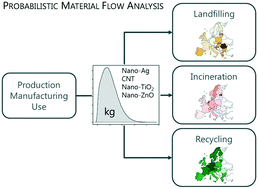European country-specific probabilistic assessment of nanomaterial flows towards landfilling, incineration and recycling†
Abstract
Improving the risk assessment of engineered nanomaterials (ENMs) requires that uncertainties in their potential releases during their complete life cycle are quantified and, as far as possible, reduced. To date, most research has focused on releases of ENM during their use and from wastewater treatment plants. Few studies have considered releases during solid waste treatment, despite the high potential for releases during these processes. This work presents an assessment of ENM flows to waste treatment processes for each European country (EU28, Norway and Switzerland). Probabilistic material flow analysis was used to model the flows of ENMs from production, manufacturing and use to waste management processes (landfilling, incineration and recycling). Modelling was based on information on the occurrence of ENMs in product applications and on the life cycles of these nanoproducts, focusing on the flows in solid waste. Data were collected to calculate the proportions of ENM-containing waste products that enter landfills, incineration and recycling plants, considering the uncertainties associated with each data source. Results show that solid wastes containing nano-Ag, -TiO2 and -ZnO mostly flow to sorting and recycling plants, while solid waste containing carbon nanotubes is most often directly disposed. Due to low data availability, many uncertainties remain in the model and its output. Most reliable results were obtained for Austria and Switzerland. These results are useful to highlight hotspots of ENM releases during waste management. However, knowledge about ENM behaviour in waste treatment processes needs to be implemented in the model to obtain final results regarding ENM flows to the environment and possibly back to reprocessing.



 Please wait while we load your content...
Please wait while we load your content...